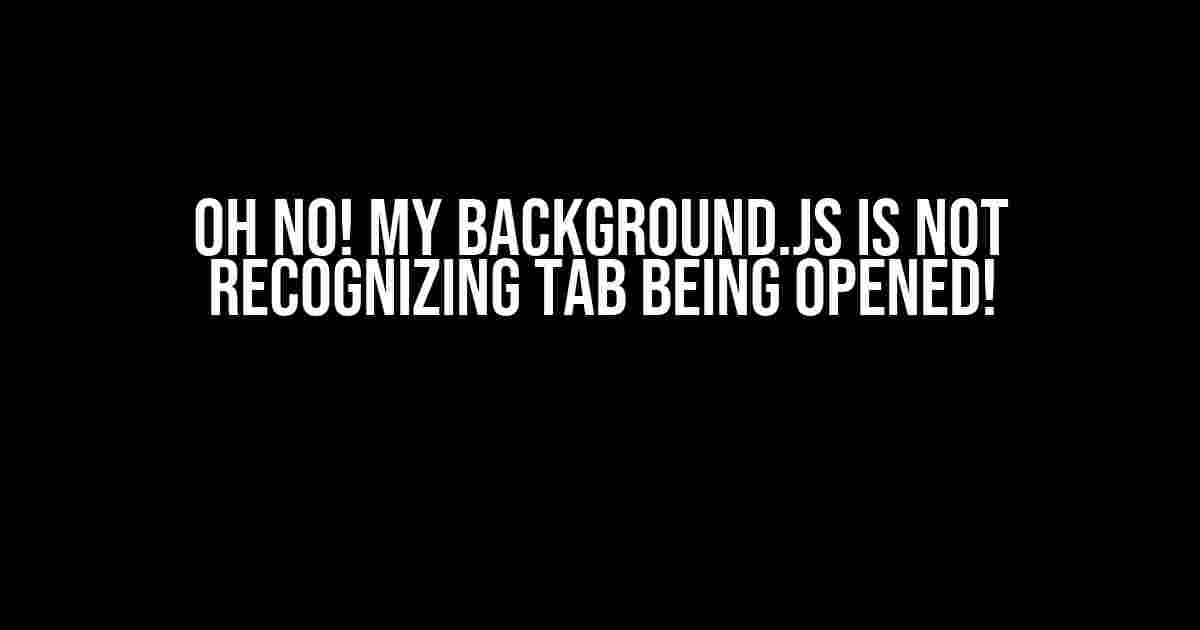Are you tired of scratching your head, trying to figure out why your background.js script is not recognizing when a new tab is opened? Well, worry no more! In this article, we’ll dive into the world of Chrome extensions and explore the possible reasons why your background script is not detecting tab openings. Buckle up, because we’re about to get technical!
What’s the Purpose of background.js?
Before we dive into the troubleshooting process, let’s take a step back and understand the role of background.js in a Chrome extension. The background script, also known as the background page, is a crucial component of a Chrome extension. Its primary function is to perform tasks that require a higher level of privilege than a content script, such as:
- Listening to events, like tab updates and page loads
- Manipulating browser actions, like icons and pop-ups
- Communicating with content scripts and other extension components
- Storing and retrieving data using the storage API
- Handling permissions and authentication
In the context of tab opening, the background script is responsible for listening to the `tabs.onCreated` event, which is fired when a new tab is created. This event is essential for many extensions, such as ad blockers, trackers, and page analyzers.
The Problem: background.js Not Recognizing Tab Opening
So, what happens when your background script fails to detect when a new tab is opened? You might experience issues like:
- The extension’s functionality is not applied to the new tab
- The extension’s UI is not updated to reflect the new tab
- Error messages or console logs indicating that the script is not running
Before we dive into the solutions, let’s explore some common reasons why your background script might not be recognizing tab openings:
- Incorrect Manifest File Configuration: A misconfigured manifest file can prevent the background script from running or listening to events.
- Script Errors or Exceptions: A syntax error or runtime exception in the background script can cause it to fail or not run at all.
- Permission Issues: Insufficient permissions or incorrect permission handling can prevent the script from accessing necessary APIs or events.
- Resource Constraints: Background scripts have limited resources and can be terminated or throttled if they consume too much memory or CPU.
Troubleshooting Steps
Now that we’ve covered the possible reasons behind the issue, let’s go through a step-by-step troubleshooting process to identify and fix the problem:
Step 1: Verify Manifest File Configuration
Open your extension’s manifest file (manifest.json) and ensure that:
- The `background` section is present and configured correctly:
{
"name": "My Extension",
"version": "1.0",
"background": {
"scripts": ["background.js"],
"persistent": false
},
...
}
{
...
"permissions": ["activeTab", "tabs"],
...
}
Step 2: Check Script Errors and Exceptions
Open the Chrome Extension’s console (chrome://extensions/, enable developer mode, and click “Inspect views: background page”) and check for any error messages or console logs:
console.error("Error in background script:", error);
Fix any syntax errors, and ensure that the script is not throwing any unhandled exceptions.
Step 3: Inspect Permission Issues
Verify that your extension has the necessary permissions to access tab information:
chrome.permissions.contains({
permissions: ["activeTab", "tabs"],
origins: [""]
}, function(result) {
if (!result) {
console.error("Insufficient permissions!");
}
});
Request the necessary permissions in your manifest file or prompt the user to grant access.
Step 4: Optimize Resource Usage
Analyze your background script’s resource usage using the Chrome Task Manager (Shift + Esc) or the Chrome Extension’s console:
console.log("Memory usage:", performance.memory);
Optimize your script to reduce memory and CPU consumption:
- Avoid using global variables and minimize memory allocation
- Use efficient algorithms and data structures
- Implement lazy loading or caching to reduce computation
Fixing the Issue: Listening to Tab Opening Events
Once you’ve identified and fixed the underlying issue, you can focus on listening to tab opening events. In your background script, add the following code:
chrome.tabs.onCreated.addListener(function(tab) {
console.log("New tab opened:", tab);
// Apply your extension's functionality to the new tab
});
This code listens to the `tabs.onCreated` event and logs a message to the console when a new tab is opened. You can then apply your extension’s functionality to the new tab, such as injecting a content script or updating the UI.
Conclusion
Troubleshooting issues with your background script can be a daunting task, but by following these steps, you should be able to identify and fix the problem. Remember to verify your manifest file configuration, check for script errors and exceptions, inspect permission issues, optimize resource usage, and finally, listen to tab opening events.
If you’re still stuck, don’t hesitate to reach out to the Chrome Extension development community or seek help from online forums. With persistence and patience, you’ll be able to get your background script recognizing tab openings in no time!
| Common Issues | Solutions |
|---|---|
| Incorrect manifest file configuration | Verify manifest file, ensure correct background script configuration and permissions |
| Script errors or exceptions | Check console logs, fix syntax errors, and handle exceptions |
| Permission issues | Verify permissions, request necessary permissions, and handle permission errors |
| Resource constraints | Optimize script resource usage, reduce memory and CPU consumption |
By following this comprehensive guide, you’ll be well on your way to resolving the issue and getting your Chrome extension up and running smoothly.
Here are 5 Questions and Answers about “My background.js is not recognizing tab being opened”:
Frequently Asked Question
Get the answers to the most commonly asked questions about troubleshooting background.js issues with tab opening recognition.
Why is my background.js not recognizing the newly opened tab?
This might happen if your script is not listening for the `tabs.onCreated` or `tabs.onUpdated` events. Make sure you’re using the correct Chrome extension APIs to detect tab changes. Check your code for any errors or typos, and try debugging it with some console logs to see if the events are being triggered.
Do I need to declare permissions in my manifest.json file?
Yes, you need to declare the `tabs` permission in your `manifest.json` file to access the Tabs API. Add the following line to your `permissions` section: `”tabs”`. This will allow your background script to access the newly opened tabs.
How do I check if my background script is running?
You can check if your background script is running by going to the Chrome extensions page (`chrome://extensions/`), enabling developer mode, and clicking on the “background page” link next to your extension’s name. This will open the Developer Tools console for your background script, where you can see any console logs or errors.
Can I use the `tabs.query` method to detect newly opened tabs?
Yes, you can use the `tabs.query` method to detect newly opened tabs. This method allows you to retrieve a list of tabs that match certain criteria. You can use it to get the newly opened tab by filtering by the `lastFocusedWindow` property.
What if I’m using a content script instead of a background script?
If you’re using a content script, it will only run on the specific page where it’s injected. To detect newly opened tabs, you’ll need to communicate with your background script using the `chrome.runtime` API. Your content script can send a message to your background script using `chrome.runtime.sendMessage`, and your background script can listen for this message to detect the newly opened tab.


